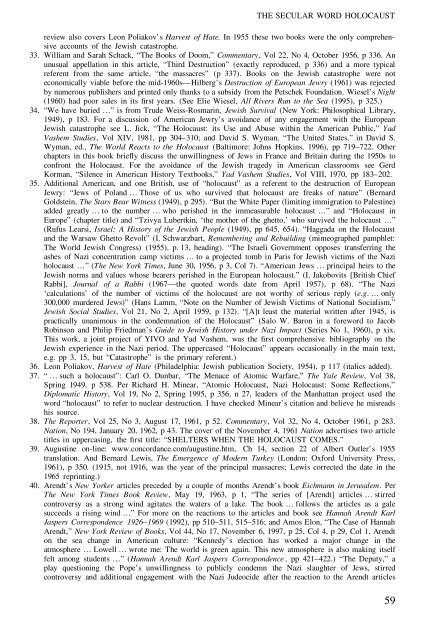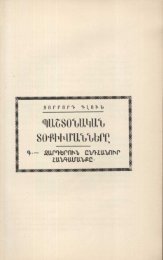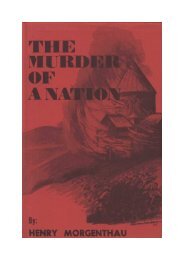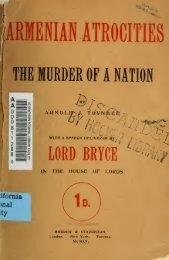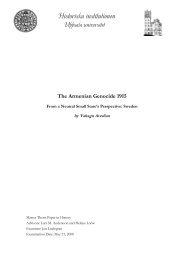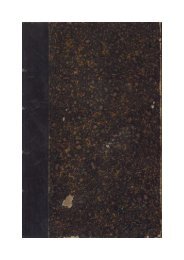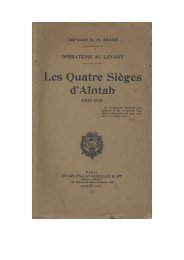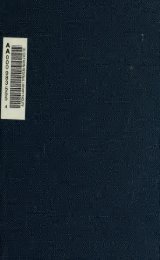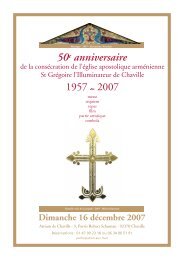The secular word HOLOCAUST: scholarly myths, history, and 20th ...
The secular word HOLOCAUST: scholarly myths, history, and 20th ...
The secular word HOLOCAUST: scholarly myths, history, and 20th ...
Create successful ePaper yourself
Turn your PDF publications into a flip-book with our unique Google optimized e-Paper software.
THE SECULAR WORD <strong>HOLOCAUST</strong>review also covers Leon Poliakov’s Harvest of Hate. In 1955 these two books were the only comprehensiveaccounts of the Jewish catastrophe.33. William <strong>and</strong> Sarah Schack, “<strong>The</strong> Books of Doom,” Commentary, Vol 22, No 4, October 1956, p 336. Anunusual appellation in this article, “Third Destruction” (exactly reproduced, p 336) <strong>and</strong> a more typicalreferent from the same article, “the massacres” (p 337). Books on the Jewish catastrophe were noteconomically viable before the mid-1960s—Hilberg’s Destruction of European Jewry (1961) was rejectedby numerous publishers <strong>and</strong> printed only thanks to a subsidy from the Petschek Foundation. Wiesel’s Night(1960) had poor sales in its rst years. (See Elie Wiesel, All Rivers Run to the Sea (1995), p 325.)34. “We have buried …” is from Trude Weiss-Rosmarin, Jewish Survival (New York: Philosophical Library,1949), p 183. For a discussion of American Jewry’s avoidance of any engagement with the EuropeanJewish catastrophe see L. Jick, “<strong>The</strong> Holocaust: its Use <strong>and</strong> Abuse within the American Public,” YadVashem Studies, Vol XIV, 1981, pp 304–310; <strong>and</strong> David S. Wyman, “<strong>The</strong> United States,” in David S.Wyman, ed., <strong>The</strong> World Reacts to the Holocaust (Baltimore: Johns Hopkins, 1996), pp 719–722. Otherchapters in this book brie y discuss the unwillingness of Jews in France <strong>and</strong> Britain during the 1950s toconfront the Holocaust. For the avoidance of the Jewish tragedy in American classrooms see GerdKorman, “Silence in American History Textbooks,” Yad Vashem Studies, Vol VIII, 1970, pp 183–202.35. Additional American, <strong>and</strong> one British, use of “holocaust” as a referent to the destruction of EuropeanJewry: “Jews of Pol<strong>and</strong> … Those of us who survived that holocaust are freaks of nature” (BernardGoldstein, <strong>The</strong> Stars Bear Witness (1949), p 295). “But the White Paper (limiting immigration to Palestine)added greatly … to the number … who perished in the immeasurable holocaust …” <strong>and</strong> “Holocaust inEurope” (chapter title) <strong>and</strong> “Tzivya Lubertkin, ‘the mother of the ghetto,’ who survived the holocaust …”(Rufus Learsi, Israel: A History of the Jewish People (1949), pp 645, 654). “Haggada on the Holocaust<strong>and</strong> the Warsaw Ghetto Revolt” (I. Schwarzbart, Remembering <strong>and</strong> Rebuilding (mimeographed pamphlet:<strong>The</strong> World Jewish Congress) (1955), p. 13, heading). “<strong>The</strong> Israeli Government opposes transferring theashes of Nazi concentration camp victims … to a projected tomb in Paris for Jewish victims of the Naziholocaust …” (<strong>The</strong> New York Times, June 30, 1956, p 3, Col 7). “American Jews … principal heirs to theJewish norms <strong>and</strong> values whose bearers perished in the European holocaust.” (I. Jakobovits [British ChiefRabbi], Journal of a Rabbi (1967—the quoted <strong>word</strong>s date from April 1957), p 68). “<strong>The</strong> Nazi‘calculations’ of the number of victims of the holocaust are not worthy of serious reply (e.g. … only300,000 murdered Jews)” (Hans Lamm, “Note on the Number of Jewish Victims of National Socialism,”Jewish Social Studies, Vol 21, No 2, April 1959, p 132). “[A]t least the material written after 1945, ispractically unanimous in the condemnation of the Holocaust” (Salo W. Baron in a fore<strong>word</strong> to JacobRobinson <strong>and</strong> Philip Friedman’s Guide to Jewish History under Nazi Impact (Series No 1, 1960), p xix.This work, a joint project of YIVO <strong>and</strong> Yad Vashem, was the rst comprehensive bibliography on theJewish experience in the Nazi period. <strong>The</strong> uppercased “Holocaust” appears occasionally in the main text,e.g. pp 3, 15, but “Catastrophe” is the primary referent.)36. Leon Poliakov, Harvest of Hate (Philadelphia: Jewish publication Society, 1954), p 117 (italics added).37. “ … such a holocaust”: Carl O. Dunbar, “<strong>The</strong> Menace of Atomic Warfare,” <strong>The</strong> Yale Review, Vol 38,Spring 1949, p 538. Per Richard H. Minear, “Atomic Holocaust, Nazi Holocaust: Some Re ections,”Diplomatic History, Vol 19, No 2, Spring 1995, p 356, n 27, leaders of the Manhattan project used the<strong>word</strong> “holocaust” to refer to nuclear destruction. I have checked Minear’s citation <strong>and</strong> believe he misreadshis source.38. <strong>The</strong> Reporter, Vol 25, No 3, August 17, 1961, p 52. Commentary, Vol 32, No 4, October 1961, p 283.Nation, No 194, January 20, 1962, p 43. <strong>The</strong> cover of the November 4, 1961 Nation advertises two articletitles in uppercasing, the rst title: “SHELTERS WHEN THE <strong>HOLOCAUST</strong> COMES.”39. Augustine on-line: www.concordance.com/augustine.htm, Ch 14, section 22 of Albert Outler’s 1955translation. And Bernard Lewis, <strong>The</strong> Emergence of Modern Turkey (London: Oxford University Press,1961), p 350. (1915, not 1916, was the year of the principal massacres; Lewis corrected the date in the1965 reprinting.)40. Arendt’s New Yorker articles preceded by a couple of months Arendt’s book Eichmann in Jerusalem. Per<strong>The</strong> New York Times Book Review, May 19, 1963, p 1, “<strong>The</strong> series of [Arendt] articles … stirredcontroversy as a strong wind agitates the waters of a lake. <strong>The</strong> book … follows the articles as a galesucceeds a rising wind …” For more on the reactions to the articles <strong>and</strong> book see Hannah Arendt KarlJaspers Correspondence 1926–1969 (1992), pp 510–511, 515–516; <strong>and</strong> Amos Elon, “<strong>The</strong> Case of HannahArendt,” New York Review of Books, Vol 44, No 17, November 6, 1997, p 25, Col 4, p 29, Col 1. Arendton the sea change in American culture: “Kennedy’s election has worked a major change in theatmosphere … Lowell … wrote me: <strong>The</strong> world is green again. This new atmosphere is also making itselffelt among students …” (Hannah Arendt Karl Jaspers Correspondence , pp 421–422.) “<strong>The</strong> Deputy,” aplay questioning the Pope’s unwillingness to publicly condemn the Nazi slaughter of Jews, stirredcontroversy <strong>and</strong> additional engagement with the Nazi Judeocide after the reaction to the Arendt articles59


